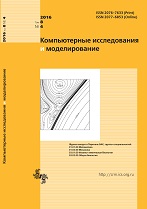|
MATHEMATICAL MODELING AND NUMERICAL SIMULATION
Cellular automata methods in mathematical physics classical problems solving on hexagonal grid. Part 1
I. V. Matyushkinab
a Molecular Electronics Research Institute,
12/1 1-y Zapadny Proezd, Zelenograd, Moscow, 124460, Russia
b Institute for Design Problems in Microelectronics of Russian Academy of Sciences,
3 Sovetskaya st., Zelenograd, Moscow, 124681, Russia
Abstract:
The paper has methodical character; it is devoted to three classic partial differential equations (Laplace, Diffusion and Wave) solution using simple numerical methods in terms of Cellular Automata. Special attention was payed to the matter conservation law and the offensive effect of excessive hexagonal symmetry.
It has been shown that in contrary to finite-difference approach, in spite of terminological equivalence of CA local transition function to the pattern of computing double layer explicit method, CA approach contains the replacement of matrix technique by iterative ones (for instance, sweep method for three diagonal matrixes). This suggests that discretization of boundary conditions for CA-cells needs more rigid conditions.
The correct local transition function (LTF) of the boundary cells, which is valid at least for the boundaries of the rectangular and circular shapes have been firstly proposed and empirically given for the hexagonal grid and the conservative boundary conditions. The idea of LTF separation into ‘internal’, ‘boundary’ and ‘postfix’ have been proposed. By the example of this problem the value of the Courant-Levy constant was re-evaluated as the CA convergence speed ratio to the solution, which is given at a fixed time, and to the rate of the solution change over time.
Keywords:
cellular automata with continuous values, hexagonal grid, finite-difference methods, partial differential equations, PDEs.
Received: 30.08.2016
Revised: 06.03.2017
Accepted: 17.03.2017
Citation:
I. V. Matyushkin, “Cellular automata methods in mathematical physics classical problems solving on hexagonal grid. Part 1”, Computer Research and Modeling, 9:2 (2017), 167–186
Linking options:
https://www.mathnet.ru/eng/crm56 https://www.mathnet.ru/eng/crm/v9/i2/p167
|

| Statistics & downloads: |
| Abstract page: | 244 | | Full-text PDF : | 123 | | References: | 33 |
|




 Contact us:
Contact us: Terms of Use
Terms of Use
 Registration to the website
Registration to the website Logotypes
Logotypes








 Citation in format
Citation in format 